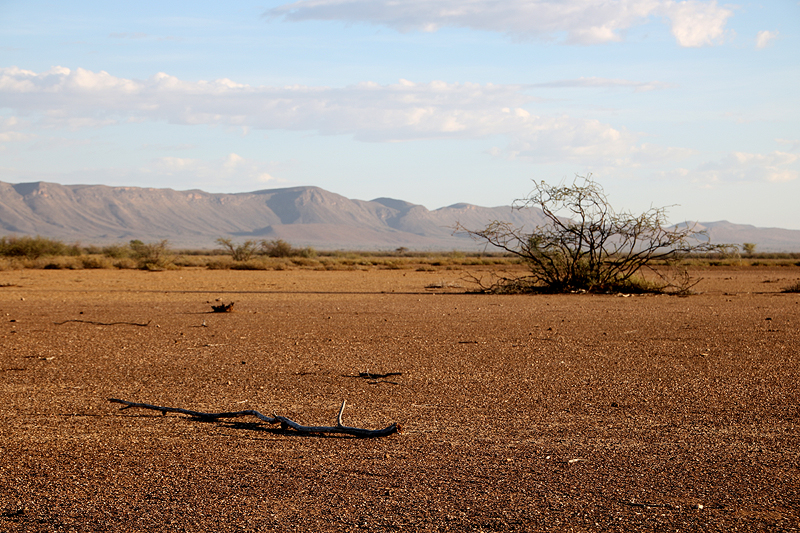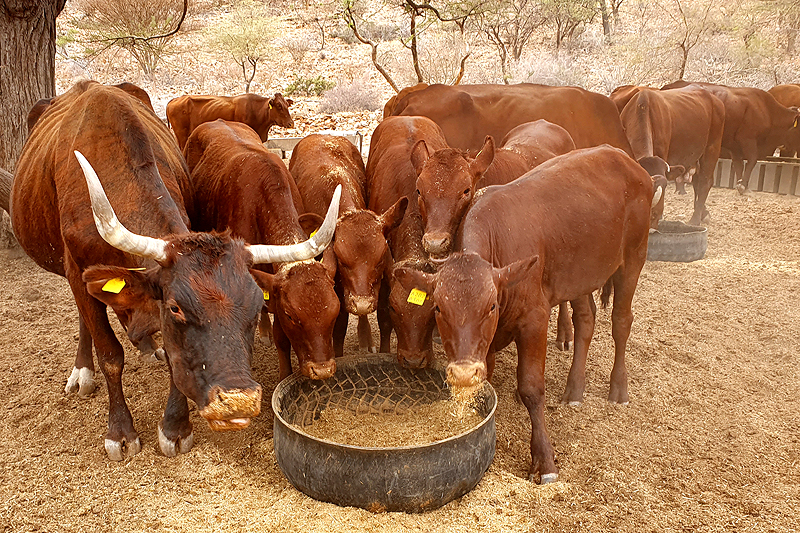Namibia, named after the oldest desert in the world, is used to dry phases. However, no farmer can remember such a severe drought. In 2018/19 there was almost everywhere less than half of the annual precipitation. BüllsPort even had only a fifth…
In May, after the official end of the rainy season, President Hage Geingob declared a national emergency. In June, only a fraction of the usual maize and mahangu (African pearl millet) harvest was brought in in northern Namibia. In the centre of the country and in the south, farmers desperately tried to sell their cattle – despite the low prices.
The abattoirs could not cope with the quantities. There were often long waiting times. The price of feed ballooned. For some farmers, the date offered by the abattoirs came too late. According to a report by the Ministry of Agriculture, around 90,000 cattle died across the country from October 2018 to September 2019.
A fifth of the normal rainfall
The severe drought hit BüllsPort particularly hard. In the rainy season 2018/19 the total amount of rain was only 24 mm. This is a fifth of the long-term annual average, which is only a modest 120 mm anyway. By way of comparison, in the centre of the country around Windhoek the annual average is about 300 mm.
However, it is not only about the total quantity, but also the distribution over time. If the grass seeds germinate after a rainfall and the next rain only falls more than ten days later, the young culms will wither. This is worse than no rain at all, because this way a lot of seeds are “wasted”. Notabene: Grasses are masters of rapid growth and seed formation, which is part of their adaptation to life on the edge of the desert…
The best example for this was the rainy season 2016/17 at BüllsPort. The total rainfall was 265 mm, more than twice the average. However, the rains were so badly distributed from October to March that they hardly resulted in pasture. The year before (2015/16) BüllsPort recorded only 98 mm, the year after (2017/18) it was 129 mm. Thus the drought year 2018/19 was the low point of a dry phase.

Scarred by the drought: Plain of farm BüllsPort in the southern centre of Namibia in January 2019. Photo: Sven-Eric Stender
Herd reduced to a tenth
BüllsPort drastically reduced the number of its cattle over the years. In 2013 it was a total of 600, distributed over its own area and two neighboring farms. Now, six years later, only 57 heads of cattle are left – 39 cows and 18 calves, including four very young ones.
Feeding is expensive. Since the severe drought affects all Namibia, BüllsPort has to buy hay from South Africa. Hay bales take up a lot of space. So haulage inflates the price even more.
The remaining 57 cattle require 550 kg of feed per day, the 23 horses need 230 kg. Thus the drought causes costs of N$ 2,000 per day due to the lack of grass alone. Per month it is about N$ 60,000.
Turning bush into forage
Many farmers now utilise their bush as an additional source of feed. It has a nutritional value similar to that of hay. BüllsPort also invested in a special mill or chaffcutter and hired seven workers to harvest the bush. This reduces the costs to N$ 1,400 a day and N $ 42,000 a month respectively.

Cattle eating ground bush at BüllsPort. Photo: Sven-Eric Stender
In Namibia no farmer can exist with 39 cows. Without a second mainstay, he cannot survive a drought financially. BüllsPort has its guest business since 1994, which supports the farm operation in periods of drought. On a farm tour, guests can see and feel what it means to farm on the edge of the desert.
No recovery anytime soon
As every year, there is no option but to hope for a good rainy season. BüllsPort received 5.5 mm rain in October and 24 mm in December. That is not enough for good pasture. However, the most promising months are still to come: In the Naukluft, the most rain usually falls in February, March and April.
But even if the rainy season is above average, Namibia should not recover from this severe drought anytime soon. The herds of cattle can only be gradually rebuilt. Cows are not for sale, everyone needs them for breeding.
On top of that, many cattle farmers lack the money to invest. They have hardly any reserves and can hardly get any income from selling cattle for slaughter. The situation is similar in South Africa. Thus food ought to become more expensive, especially meat. Namibia travellers will also feel this because accommodations are forced to raise their rates.
Newsletter “Naukluft Mail”
Straight from the Naukluft to your mailbox: News, information and exciting stories about the guest business and farm operations of BüllsPort, as well as the mountains of the Naukluft. Subscribe to our quarterly newsletter “Naukluft Mail”.

